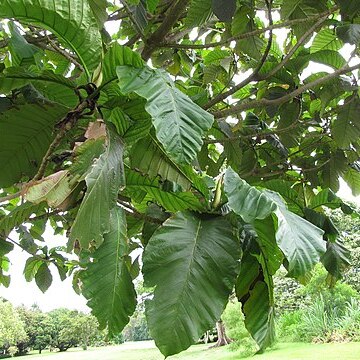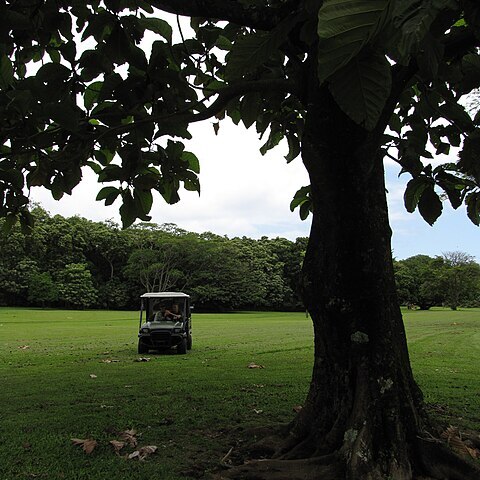Tree up to 40 m tall, evergreen. Leafy twigs 10-20 mm thick, minutely brown to whitish appressedly puberulous and also brown strig(ill)ose to subhirsute, smooth, drying dark brown to blackish; lenticels in the upper part of the internode; scars of the stipules prominent. Leaves spirally arranged; lamina subcoriaceous, entire, elliptic, 20-40(-70) by 10-25(-50) cm, or when juvenile ± pinnately incised with 2 or 3 pairs of lobes, apex short-acuminate, base rounded to cuneate, margin entire to repand or lobate; upper surface sparsely brown hirtellous on the midrib, smooth; lower surface brownish puberulous to strigillose on the smaller veins to subhirsute on the main veins or midrib, usually scabridulous; lateral veins 10-16 pairs, most of them branched or forked away from the margin, tertiary venation scalariform, prominent; areoles usually bullate; petiole 2-7.5 cm long, 3-6 mm thick, minutely brownish appressedly puberulous and also brown hirtellous to subhirsute or strigillose, the epidermis persistent; stipules fully amplexicaul, 6-12 cm long, brown subhirsute to subvillous, caducous. Staminate inflorescences axillary, solitary; peduncle 3-10 cm long, brown appressedly puberulous; head cylindrical, 3.5-10 by 1.5-2 cm, sulcate, the grooves ± (spirally) twisted; perianth tubular c. 1.5 mm long, the apex 2-lobed, minutely puberulous; stamen c. 1.8 mm long, anther c. 0.4 mm long; interfloral bracts absent. Pistillate inflorescences axillary, solitary; peduncle 6-18 cm long, brown appressedly puberulous and hirtellous; head ellipsoid to cylindrical; perianth tubular, brownish appressedly puberulous, the apex convex; stigma simple, twisted; the flowers intermixed with 1-3.5 cm long filiform processes, these brown puberulous to strigillose hirtellous and thickened at the apex. Infructescences ellipsoid to cylindrical or to subglobose, up to (6-)8-12(-17) by 5.5(-10) cm, covered with 3-4 mm long conical apices of the perianths (hidden by the processes); fruits ellipsoid, c. 1 cm long.
More
A large tree. It grows up to 40 m tall. It has a trunk 60 to 90 cm across. The leaves are dark green. The leaves are alternate and crowded. Young leaves are lobed but older leaves are entire. They are blunt in form at both ends. The larger leaves are 20 to 30 cm wide and 60 to 90 cm long. The male flower spikes are like a cylinder and soft and spongy and yellow. The female flower heads are rounded. The fruit are heavy and 10-15 cm or more long. The fruit is covered with soft spines. These are covered with brownish hairy processes. (Like a rambutan.) The fruit is a bright orange. The seeds are in a white gummy pulp. The pulp is edible. The seeds are edible.
It is a tropical plant. It suits fertile soils which have been formed by rivers. It is in evergreen forests up to 500 m altitude. They are found in Quezon, Bicol, Surigao and Davao both cultivated and wild in the Philippines. In the Cairns Botanical Gardens.
More
Rainforests. Evergreen forests, usually at elevations up to 300 metres but sometimes extending to 900 metres.



